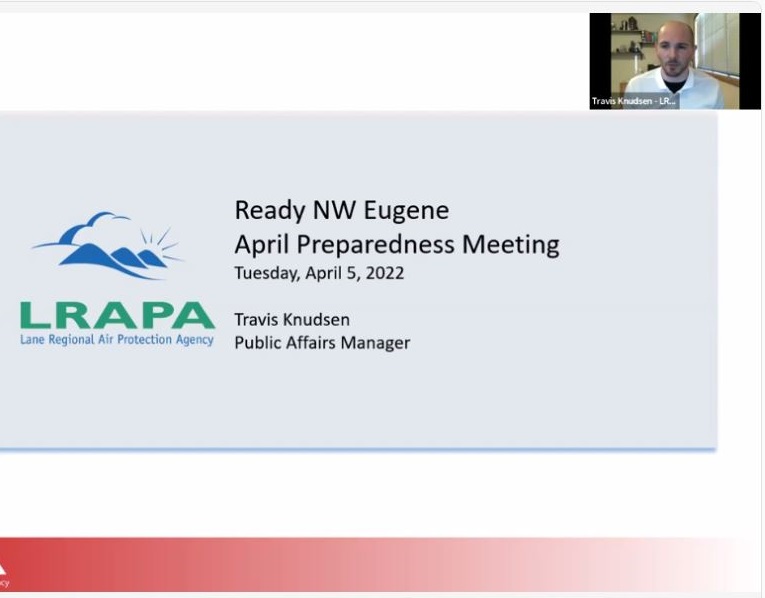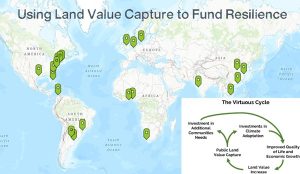LRAPA offers tips for checking air quality, staying healthy during wildfire season
7 min read
With wildfire season starting earlier each year, three northwest Eugene neighborhoods invited Lane County’s air quality experts to share some tips.
[00:00:09] Jacque Wurster: We have Travis Knudsen here from LRAPA, who’s going to talk to us about air quality.
[00:00:14] Travis Knudsen: Thanks, Jacque, and hello everybody, my name is Travis Knudsen. I’m the public affairs manager for the Lane Regional Air Protection Agency. LRAPA is the local regulatory authority responsible for monitoring and potentially protecting the air quality.
[00:00:29] I’m sure all of us remember last year, which was a rough year. Oakridge, for example, had a rough 2021 wildfire season. And then locally here in the Eugene Springfield area, 2020 was a really rough year, with the worst air quality we have seen.
[00:00:42] Wildfire seasons driven by climate change is becoming a broader problem, with our wildfire season starting earlier, lasting longer, and also being more intense at times.
[00:00:52] So from an informational perspective from just knowing, is the air quality okay enough outside, or is it bad enough that maybe I need to do something to lower my exposure? The best place to find out what the air quality is: Fire.AirNow.gov.
[00:01:07] John Q: The website maps results from air quality sensors throughout Lane County.
[00:01:12] Travis Knudsen: Commercial air monitors have become significantly more popular over the last few years. The PurpleAir sensor is one of the ones that actually has turned out to be very precise. And so because of that, LRAPA has been slowly installing PurpleAirs across Lane County. We’ve actually installed over 90 of them throughout Lane County.
[00:01:31] What’s special about this site is that it uses both PurpleAir sensors and those really expensive government-grade monitors.
[00:01:40] It’ll tell you a lot of other great information such as the trend. Is the air quality holding steady? Is it decreasing? Is it improving? What is it doing? And it’ll provide you with recommendations. It has a graph that’ll go back a few days and it’ll show you what the air quality has done over the last couple of days for that sensor, which can be useful as well.
[00:01:59] And while the Fire.AirNow.gov website is great for using on the computers, the EPA has created the AirNow app. And if you download that app, it’s available on iPhones as well as Android phones.
[00:02:11] John Q: Travis said it’s important to check the air quality all year round.
[00:02:15] Travis Knudsen: That’s because of the health impacts of PM 2.5, and PM 10 pollution. PM stands for particulate matter and the 2.5 and the 10 numbers just designate how small that particular particle is. A human hair is about 50 to 70 micrograms. So PM 10 is pretty small, being that it’s 10 micrograms or less. PM 2.5 is even smaller than that, it’s 2.5 micrograms or less.
[00:02:44] The Oregon Health Authority, they talk about this a lot, but health study after health study shows that the worst pollution we can be exposed to is PM 2.5, because the PM 2.5 particles are so small that when you inhale them, they will get really deep into your lungs and they will become entrapped in your lungs and they will never leave your lungs.
[00:03:05] And they’re even so small that they can penetrate your lungs and get into your bloodstream and then accumulate elsewhere in your body. And that can create a lot of health problems.
[00:03:15] With wildfire season, I think we can all agree, we have an expectation now that every summer for three, four or five days, there will be reduced air quality because of smoke from wildfires.
[00:03:27] If you have that exposure for a couple of days every summer over a lifetime, and that PM 2.5 pollution never leaves your lungs and it just continues to accumulate, that’s where we can later in life really start to see some consequences from that exposure. Taking action when air quality does diminish to lower our exposure of PM 2.5 is really important to protect our health in the future.
[00:03:51] And the biggest drivers of PM 2.5 pollution in Lane County are from wildfire smoke, winter stagnation and woodstove use, from motor vehicles, particularly diesel engines create a lot of PM 2.5 pollution. And then industry creates PM 2.5 pollution, but industry PM 2.5 pollution compared to even woodstove is significantly less.
[00:04:15] John Q: Travis described the Air Quality Index (AQI), which combines data from different sensors to come up with a numeric score and a green/yellow/red color code.
[00:04:24] Travis Knudsen: So there are ways to protect your health. and the best way is to just follow those AQI guidelines to reduce or avoid exposure to poor air quality.
[00:04:33] The heating system in your home, swapping out filters, about every three months you should be switching that out. And if you have a filter with MERV 13, that’ll filter that PM 2.5 pollution.
[00:04:45] You can use a HEPA air filter and air purifier in your home. People are realizing that they want to have some sort of indoor air filtration so retailers are supplying more of them. but right around wildfire season is when they become scarce. So this is the time that everything’s in stock to where you should consider doing that.
[00:05:03] If you have one of those MERV 13 or higher air filters and you have a box fan, you can essentially take a bungee cord and bungee-cord it to the box fan, and that too will work as a HEPA air filter. Really all you need is just the air filter and you need air in your home moving through that filter.
[00:05:20] The next thing you should do is to repair and replace drafty windows and unsealed doorways. And when the indoor or the outdoor air is really bad, those are instances when you want to even try limiting how often you open the door to go outside, because every time that door opens, air comes in and that the air outside is really bad, it’s going to come inside and degrade your indoor air quality.
[00:05:42] John Q: Gas stoves also emit PM 2.5 pollution.
[00:05:45] Travis Knudsen: I love my gas stove. When it is lit and it’s burning, that is emitting PM 2.5 pollution and indoor air quality can degrade really rapidly if you have a gas stove. So I turn on the fan in the kitchen when I’m lighting the stove. And then whenever I’m cooking on that stove, making sure that that fan is on to help pull that pollution that PM 2.5 out of my kitchen to protect my indoor air quality.
[00:06:09] John Q: Travis was asked about smoke from outdoor burning. He encouraged citizens to contact LRAPA.
[00:06:15] Travis Knudsen: There are times where LRAPA is limited in what we can do or the way that we can respond, be it to an industrial facility or to an agricultural burn. But letting LRAPA know that you are having this lived experience of being impacted by smoke, we keep records of all air quality complaints that we receive. We have a database of it and down the road, having that record of, ‘Here is a list of citizens who have been impacted this way,’ that doesn’t mean that LRAPA necessarily can fix the problem, but we can write it down and save it in our database and then in the future, if you and your neighbors and plenty of other people do that collectively, that can show that there is an impacted community and that can be helpful in conversations in the future.
[00:06:56] John Q: A question from Joel Robe.
[00:06:57] Joel Robe: We’ve got N95 masks for COVID, but that seems to that’s five microns, I think, and you said 2.5. So would we need something like an N99 mask?
[00:07:09] Travis Knudsen: That’s a really good question. N95 masks are effective screens against PM 2.5 pollution. They don’t filter all of it, but again, it’s bringing that air quality from what would be hazardous, very unhealthy, to bring it down to a level that is more acceptable for you to breathe.
[00:07:27] And another question that comes up that’s very common is AC (air conditioning) units such as the window ones, and the idea that you can’t turn the AC on because the smoke is bad. That’s something you can do because those window AC units don’t actually allow airflow to pass through it. It just cools the air and re-circulates the indoor air. But I would certainly emphasize the importance of making sure that your seal, that AC unit in the window, is a very good seal because that’s more likely where you’re going to see any outdoor air come on in.
[00:07:59] Fred Miller: I wouldn’t run the dryer either because it’s pushing air out and that air has to come from somewhere.
[00:08:06] Travis Knudsen: That’s a good point, Fred. Yes. I agree with that.
[00:08:09] Judy Boles: Are you included in the alerts that would come from Alert Sense? Or do we have to separately sign up on an LRAPA site?
[00:08:20] Travis Knudsen: If there was a instance where we saw a repeat, like with the Holiday Farm Fire, the Alert Sense would be utilized in that way. But when it comes to more smaller changes in air quality, whether it’s from ‘Good’ to even the ‘Unhealthy For Sensitive Groups,’ that’s something that happens frequently enough in our area that there wouldn’t be any kind of Alert Sense notifications to that because it would be common enough that I think people would maybe start to respond less when that Alert Sense went off.
[00:08:47] So that’s a tool that’s really helpful, but something to be used sparingly for those extreme situations. So the better route is really to just be mindful of the air quality and have the app on your phone, or know that website to just check it every so often, especially if you’re unsure what that air quality is.
[00:09:03] John Q: LRAPA recommends the Air Now mobile app and the website Fire.AirNow.gov.



